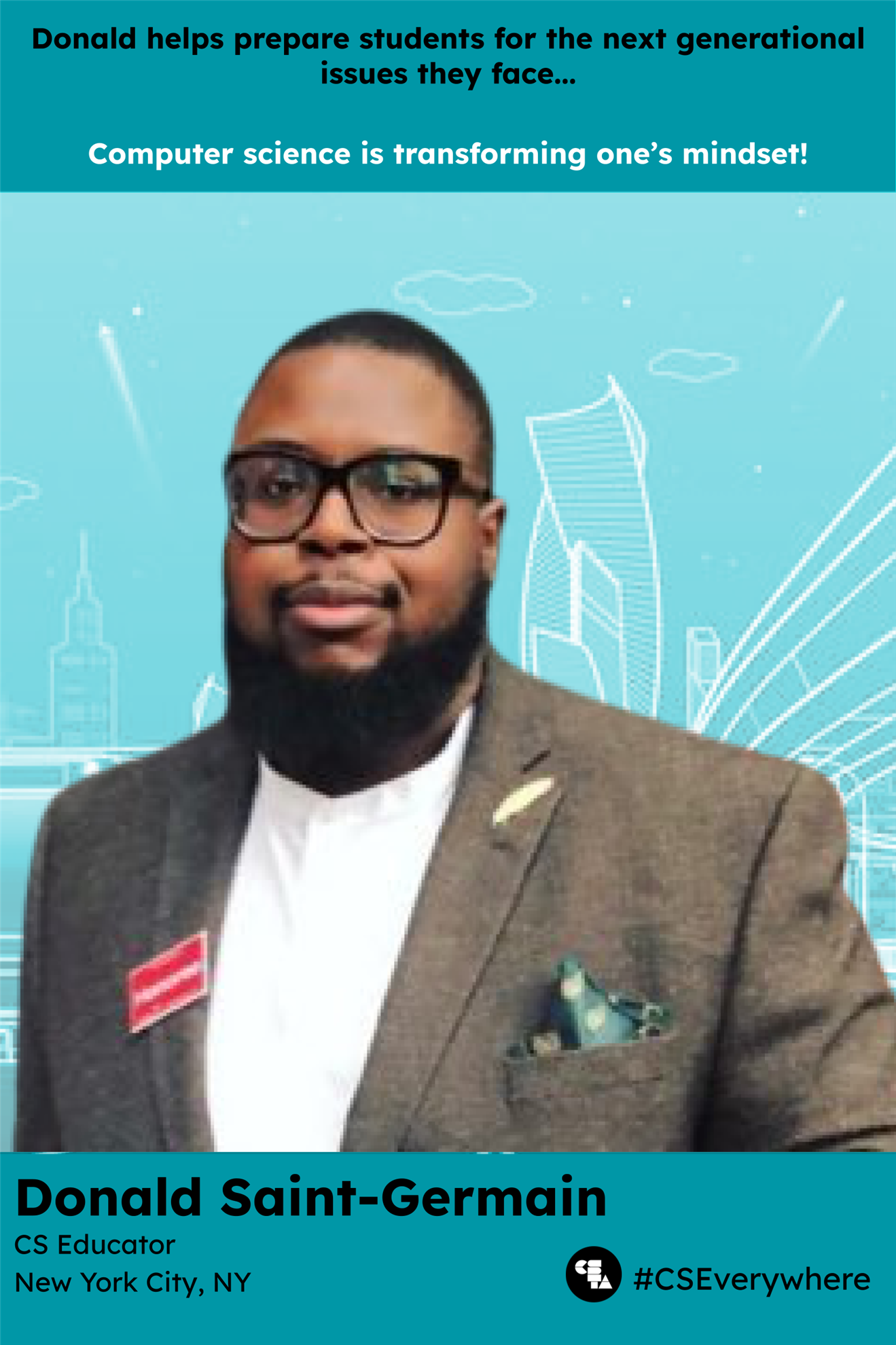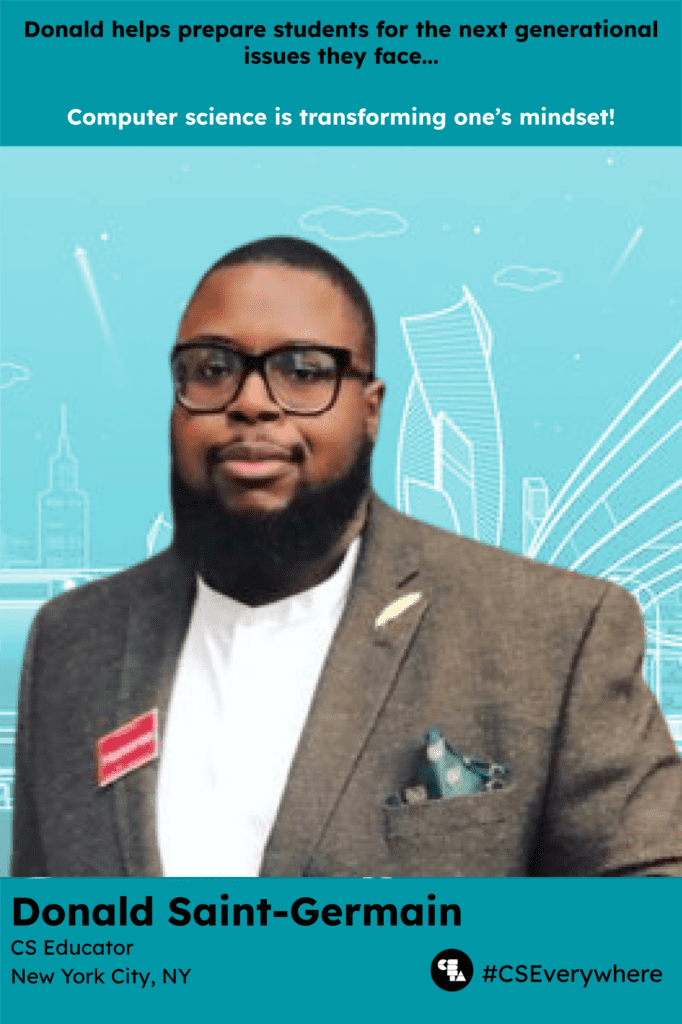
“Five years ago I was interested in learning about CS opportunities I wish were available to me when I was in high school,” said CSTA Equity Fellow Donald Saint-Germain.
Full Story
 “Five years ago I was interested in learning about CS opportunities I wish were available to me when I was in high school,” said CSTA Equity Fellow Donald Saint-Germain. “My passion to provide my students with CS opportunities so that they can be better prepared for the world they are living in motivated me to participate and become a CS teacher.”
“Five years ago I was interested in learning about CS opportunities I wish were available to me when I was in high school,” said CSTA Equity Fellow Donald Saint-Germain. “My passion to provide my students with CS opportunities so that they can be better prepared for the world they are living in motivated me to participate and become a CS teacher.” Saint-Germain is a high school computer science and 9-12 English Language Arts teacher in New York City at the Bronx School for Law, Government, and Justice. He embarked on his journey into CS via professional developments offered by the NYCDOE CS4ALL team since 2016. He’s passionate about incorporating technology into the classroom to improve students’ learning opportunities as he sees this as a vital aspect in preparing his students to be active participants in the 21st Century.
Saint-Germain’s vision for delivering CS education focuses on expanding opportunities for each grade level to provide more learning opportunities for students in and outside of the classroom.
“Understanding who my students are and what skill sets they bring to my classroom and what skill sets they need to be successful in my classroom are crucial in my practice of teaching,” shared Saint-Germain. “Seeing my students as people who want to be successful and need certain resources to reach success in my classroom helps define equity for me in my classroom.”
“Equity for me is defined as understanding the needs of my students and providing them the necessary resources so they each individually will be prepared with the resources needed to be successful in the task/ lesson at hand,” continued Saint-Germain. “Providing my students with the resources they need, rather than general resources that hopefully can work for them, helps to create an equitable environment in my classroom as it targets limitations preventing these students from being successful. This isn’t easy but to ensure I’m supporting all my students I push myself to ensure that I’m holding myself accountable to this definition so that I’m creating a more equitable environment for all.”
Saint-Germain works to ensure everyone in his classroom feels supported and welcomed in their shared learning environment. To create this space, he identifies opportunities to learn from his students, via survey and direct questioning, and leverages this information to help create a more equitable space in his classroom. “I also seek information from past teachers and the family members of my students to ensure I can best support them and their specific needs in my classroom,” shared Saint-Germain. “All of this works hand in hand to define and implement equality for me.
His background informs his teaching. “Born and raised in NYC, I’m aware of how this large city can be so easily segregated in regards to race, class, socioeconomic status, etc.” he shared. “Going to a public HS in Manhattan, I was privileged to experience many opportunities including internship opportunities and AP exams.”
“When I began teaching HS in the Bronx I truly realized how privileged I was when noticing how very few of these opportunities were offered to my students in the same city that I went to high school in years later,” he concluded. “Limited access to internships and AP exams diminish opportunities for students to receive an affordable college education and real-world work experience to prepare them for a career they may be interested in. To disrupt these inequities, I worked with my administration to increase the representation of students from low socioeconomic backgrounds in taking the AP Computer Science Principles Exam and provided many of these students with internship opportunities while I taught CS to them over the past five years. Disrupting this injustice also led to tripling the number of students with disabilities and English language learners taking at least one AP exam at my school before they graduate.”
Saint-Germain established partnerships to open up additional opportunities available for his students. “From field trips to major tech companies such as Microsoft, Facebook, OATH (AOL and Yahoo) to name a few, hack-a-thons, competitions, scholarships, internships, etc., there are a plethora of opportunities available that demonstrate all the opportunities available within CS education,” he shared. “Competitions such as this and internship opportunities I have previously mentioned break down stereotypes of what CS looks like and who is allowed to participate, which opens doors for new students like my own.”
Saint-Germain has found it best to partner with and learn from other teachings looking to disrupt the disparities in CS education. This led him to apply for the CSTA Equity Fellowship, to learn and develop as a CS educator by discussing what works and learning from the experiences of others.
Learn more about the CSTA Equity Fellowship and this year’s cohort here.

